lock ASTON MARTIN DB7 1997 Owner's Manual
[x] Cancel search | Manufacturer: ASTON MARTIN, Model Year: 1997, Model line: DB7, Model: ASTON MARTIN DB7 1997Pages: 421, PDF Size: 9.31 MB
Page 187 of 421
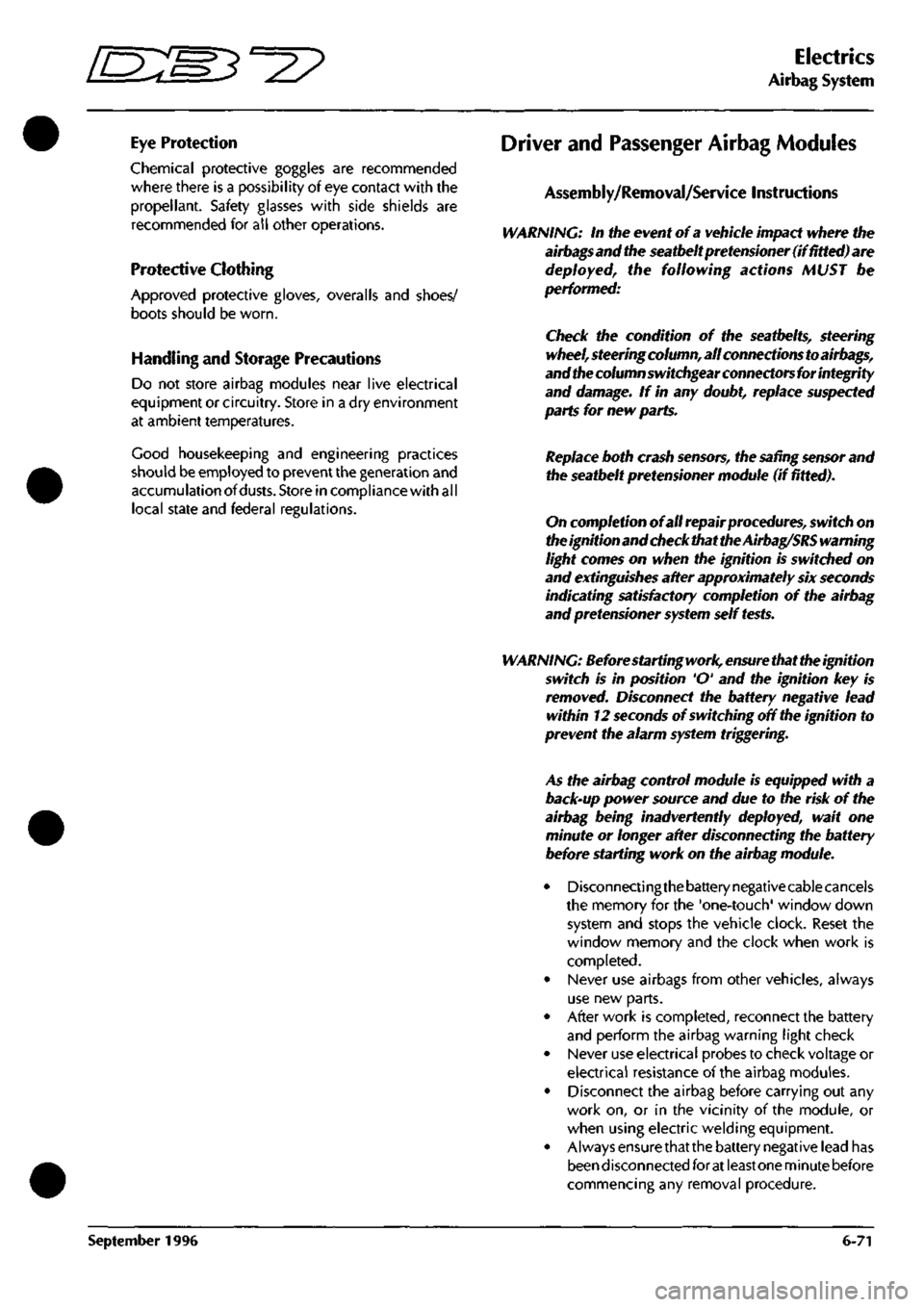
^=2?
Electrics
Airbag System
Eye Protection
Chemical protective goggles are recommended
where there is a possibility of eye contact with the
propellant. Safety glasses with side shields are
recommended for all other operations.
Protective Clothing
Approved protective gloves, overalls and shoes/
boots should be worn.
Handling and Storage Precautions
Do not store airbag modules near live electrical
equipment or circuitry. Store in a dry environment
at ambient temperatures.
Good housekeeping and engineering practices
should be employed to prevent the generation and
accumulation of
dusts.
Store in compliance with all
local state and federal regulations.
Driver and Passenger Airbag Modules
Assembly/Removal/Service Instructions
WARNING: In the event of a vehicle impact where the
airbags and the seatbeltpretensioner (if fitted) are
deployed, the following actions MUST be
performed:
Check the condition of the seatbelts, steering
wheel,
steering column, all connections to airbags,
and the column switchgear connectors for integrity
and damage. If in any
doubt,
replace suspected
parts for new parts.
Replace both crash
sensors,
the
safing sensor
and
the seatbelt pretensioner module (if fitted).
On completion of all repair procedures, switch on
the ignition and check that the
Airbag/SRS
warning
light comes on when the ignition is switched on
and extinguishes after approximately six seconds
indicating satisfactory completion of the airbag
and pretensioner
system
self
tests.
WARNING: Before starting
work,
ensure
that the ignition
switch is in position 'O' and the ignition key is
removed.
Disconnect the battery negative lead
within 12 seconds of switching off the ignition to
prevent the alarm system triggering.
As the airbag control module is equipped with a
back-up power source and due to the risk of the
airbag being inadvertently deployed, wait one
minute or longer after disconnecting the battery
before starting work on the airbag module.
• Disconnectingthe battery negative cable cancels
the memory for the 'one-touch' window down
system and stops the vehicle clock. Reset the
window memory and the clock when work is
completed.
• Never use airbags from other vehicles, always
use new parts.
• After work is completed, reconnect the battery
and perform the airbag warning light check
• Never use electrical probes to check voltage or
electrical resistance of the airbag modules.
• Disconnect the airbag before carrying out any
work on, or in the vicinity of the module, or
when using electric welding equipment.
• Always ensure that the battery negative lead has
been disconnected for at least one minute before
commencing any removal procedure.
September 1996 6-71
Page 188 of 421
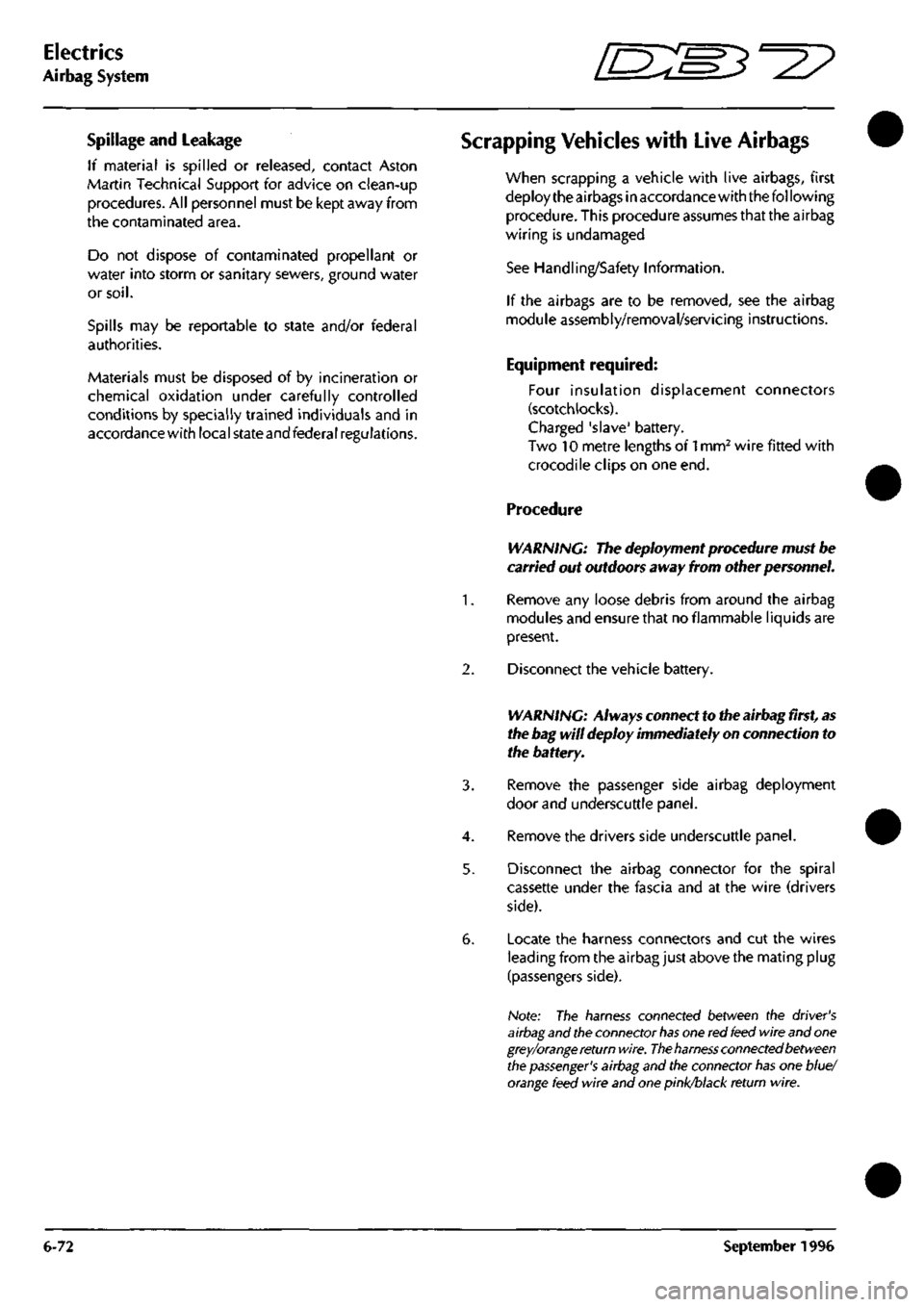
Electrics
Airbag System =7?
Spillage and Leakage
If material is spilled or released, contact Aston
Martin Technical Support for advice on clean-up
procedures. All personnel must be kept away from
the contaminated area.
Do not dispose of contaminated propellant or
water into storm or sanitary sewers, ground water
or
soil.
Spills may be reportable to state and/or federal
authorities.
Materials must be disposed of by incineration or
chemical oxidation under carefully controlled
conditions by specially trained individuals and in
accordancewith local stateandfederal regulations.
Scrapping Vehicles with Live Airbags
when scrapping a vehicle with live airbags, first
deploy the airbags in accordance with the following
procedure. This procedure assumes that the airbag
wiring is undamaged
See Handling/Safety Information.
If the airbags are to be removed, see the airbag
module assembly/removal/servicing instructions.
Equipment required:
Four insulation displacement connectors
(scotch locks).
Charged 'slave' battery.
Two 10 metre lengths of
1
mm^ wire fitted with
crocodile clips on one end.
Procedure
WARNING: The deployment procedure must be
carried out outdoors away from other personnel.
1.
Remove any loose debris from around the airbag
modules and ensure that no flammable liquids are
present.
2.
Disconnect the vehicle battery.
WARNING: Always connect to the airbag
first,
as
the bag will deploy immediately on connection to
the battery.
3. Remove the passenger side airbag deployment
door and underscuttle panel.
4.
Remove the drivers side underscuttle panel.
5. Disconnect the airbag connector for the spiral
cassette under the fascia and at the wire (drivers
side).
6. Locate the harness connectors and cut the wires
leading from the airbag just above the mating plug
(passengers side).
Note: The harness connected between the driver's
airbag
and the connector
has
one red
feed
wire and
one
grey/orange return
wire.
The
harness
connected between
the
passenger's
airbag and the connector
has
one blue/
orange
feed wire and one
pinl
return wire.
6-72 September1996
Page 189 of 421
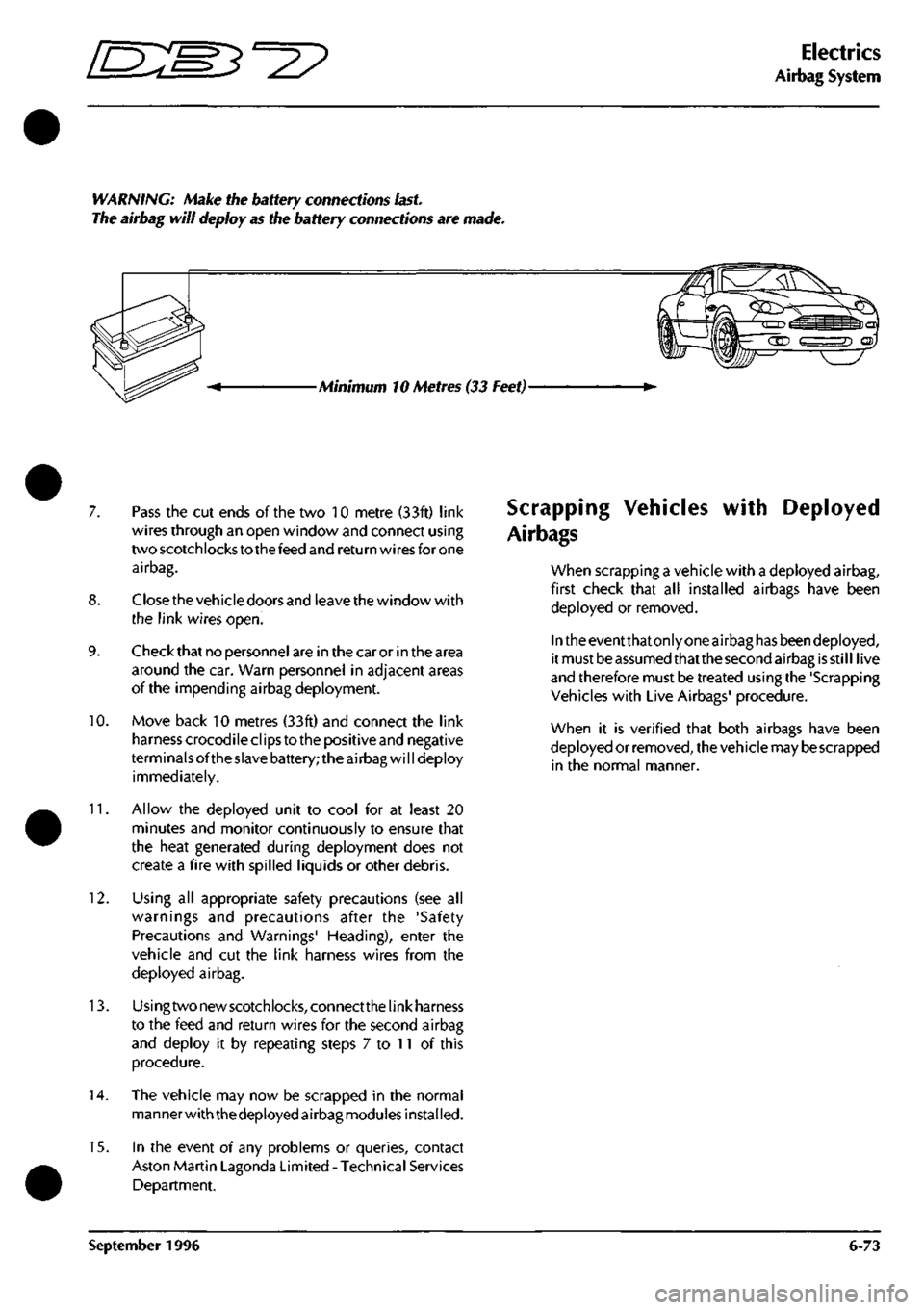
^^
Electrics
Airbag System
WARNING: Make the battery connections
last.
The airbag will deploy as the battery connections are made.
Minimum 10 Metres (33 Feet)-
7. Pass the cut ends of the two 10 metre (33ft) link
wires through an open window and connect using
two scotchlocks to the feed and return wires for one
airbag.
8. Closethe vehicle doors and leave the window with
the link wires open.
9. Check that no personnel are in the car or in the area
around the car. Warn personnel in adjacent areas
of the impending airbag deployment.
10.
Move back 10 metres (33ft) and connect the link
harness crocodile clips to the positive and negative
terminals ofthe slave battery; the airbag will deploy
immediately.
11.
Allow the deployed unit to cool for at least 20
minutes and monitor continuously to ensure that
the heat generated during deployment does not
create a fire with spilled liquids or other debris.
12.
Using all appropriate safety precautions (see all
warnings and precautions after the 'Safety
Precautions and Warnings' Heading), enter the
vehicle and cut the link harness wires from the
deployed airbag.
13.
Usingtwonewscotchlocks,connectthelinkharness
to the feed and return wires for the second airbag
and deploy it by repeating steps 7 to 11 of this
procedure.
14.
The vehicle may now be scrapped in the normal
manner with thedeployed airbag modules installed.
15.
In the event of any problems or queries, contact
Aston Martin Lagonda Limited - Technical Services
Department.
Scrapping Vehicles
Air bags
with Deployed
when scrapping a vehicle with a deployed airbag,
first check that all installed airbags have been
deployed or removed.
In the eventthatonly one airbag has beendeployed,
it must be assumed thatthe second airbag is still live
and therefore must be treated using the 'Scrapping
Vehicles with Live Airbags' procedure.
when it is verified that both airbags have been
deployed or removed, the vehicle may
be
scrapped
in the normal manner.
September 1996 6-73
Page 191 of 421
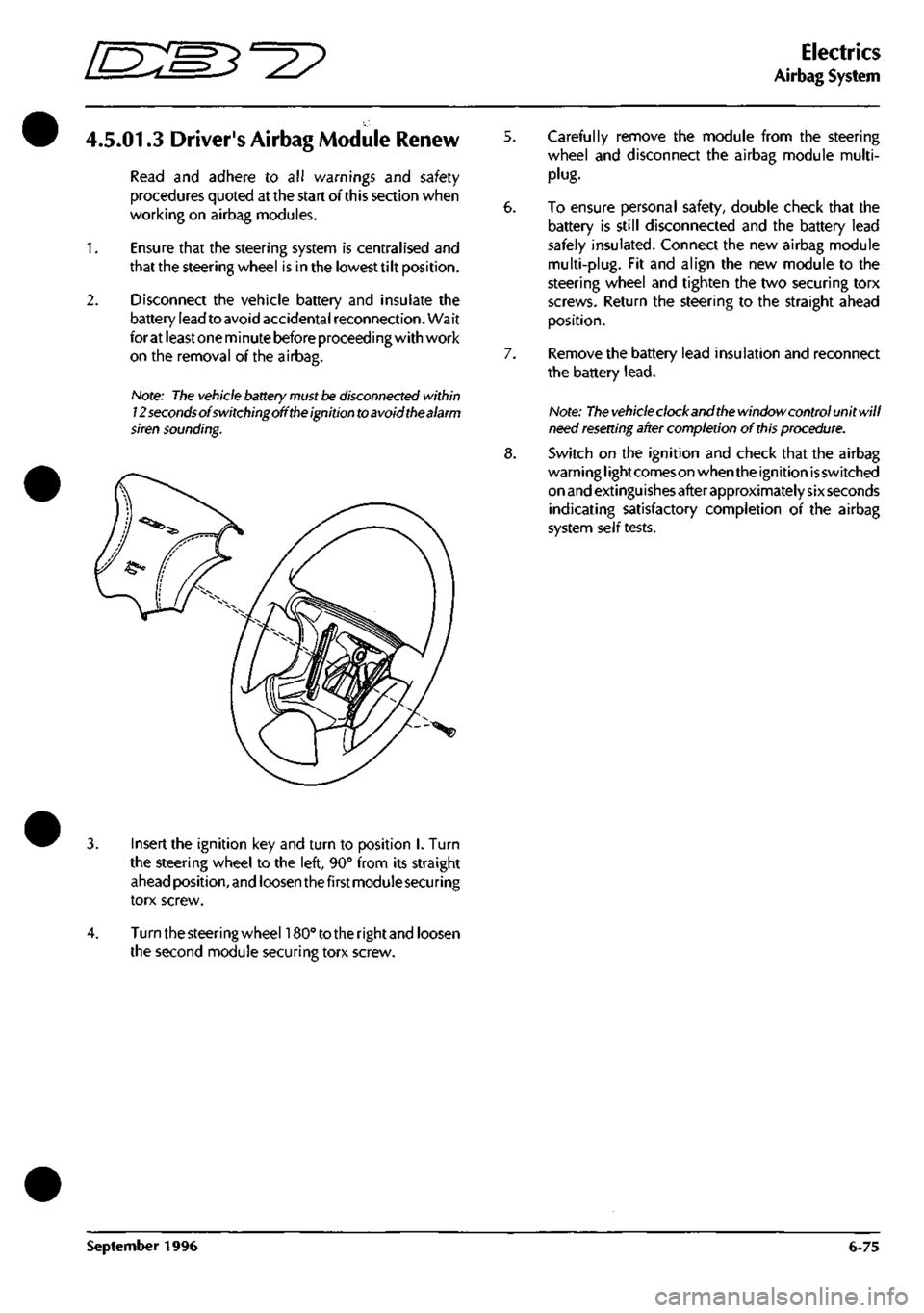
'=2?
Electrics
Airbag System
4.5.01.3 Driver's Airbag Module Renew
Read and adhere to all warnings and safety
procedures quoted at the start of this section when
working on airbag modules.
1.
Ensure that the steering system is centralised and
that the steering wheel is in the lowest tilt position.
2.
Disconnect the vehicle battery and insulate the
battery lead to avoid accidental reconnection. Wait
for at least one minute before proceeding with work
on the removal of the airbag.
Hote: The vehicle battery
must be
disconnected within
12 seconds of switching off
the
ignition to avoid the alarm
siren sounding.
5. Carefully remove the module from the steering
wheel and disconnect the airbag module multi-
plug.
6. To ensure personal safety, double check that the
battery is still disconnected and the battery lead
safely insulated. Connect the new airbag module
multi-plug.
Fit and align the new module to the
steering wheel and tighten the two securing torx
screws. Return the steering to the straight ahead
position.
7. Remove the battery lead insulation and reconnect
the battery
lead.
Note:
The vehicle
clockandthe window control unitwill
need
resetting
after completion of
this
procedure.
8. Switch on the ignition and check that the airbag
warni ng
I
ight comes on when the ignition is switched
on and extinguishes after approximately sixseconds
indicating satisfactory completion of the airbag
system self tests.
Insert the ignition key and turn to position I. Turn
the steering wheel to the left, 90° from its straight
ahead position, and loosen thefirstmoduiesecuring
torx screw.
Turn the steering wheehSO" to the rightand loosen
the second module securing torx screw.
September 1996 6-75
Page 192 of 421
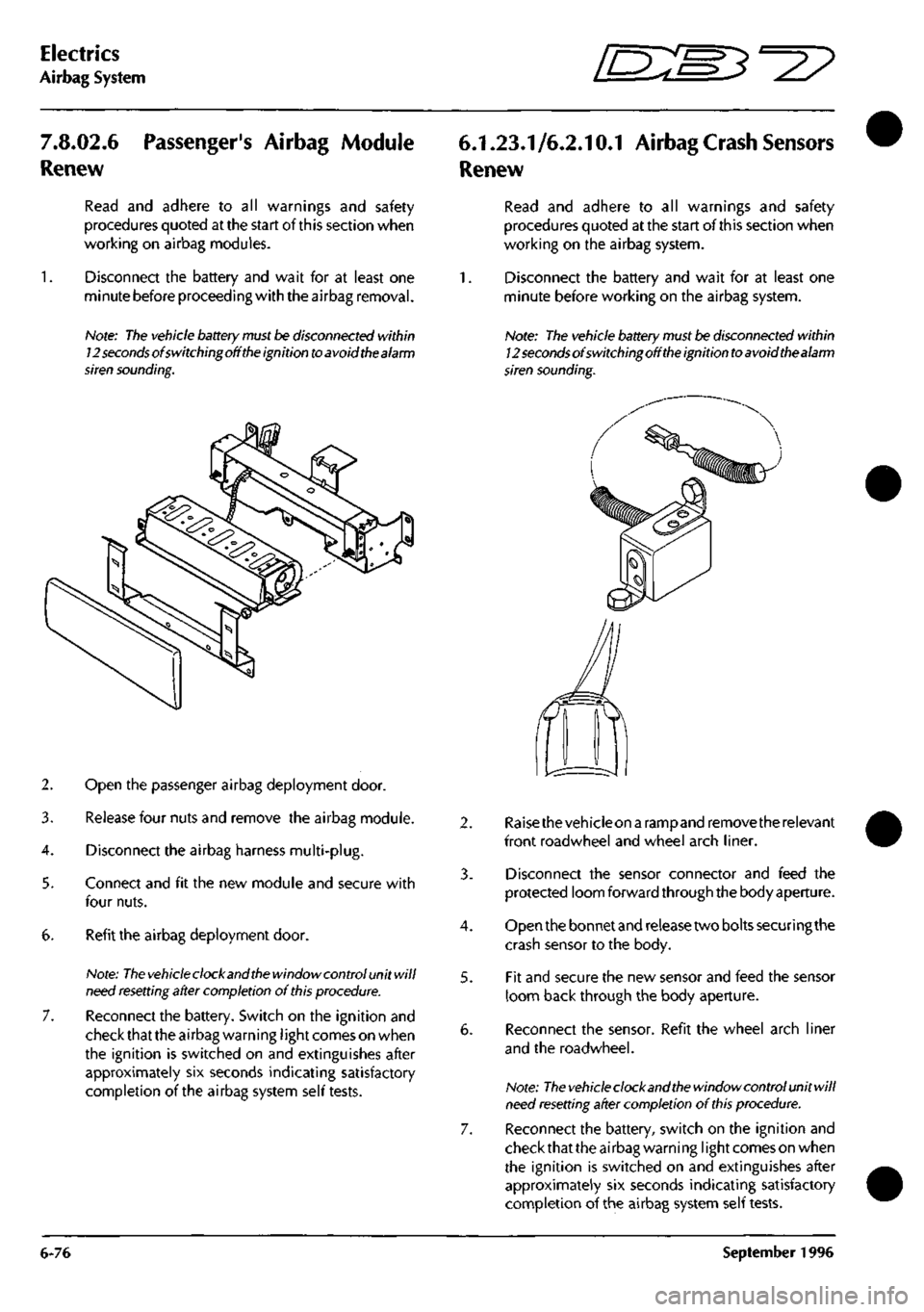
Electrics
Airbag System ^^?
7.8.02.6
Renew
Passenger's Airbag Module
Read and adhere to all warnings and safety
procedures quoted at the start of this section when
working on airbag modules.
Disconnect the battery and wait for at least one
minute before proceeding with the airbag removal.
Note:
The
vehicle battery
must
be disconnected within
12
seconds
of switchingoff
the
ignition
to
avoid the alarm
siren sounding.
2. Open the passenger airbag deployment door.
3. Release four nuts and remove the airbag module.
4.
Disconnect the airbag harness multi-plug.
5. Connect and fit the new module and secure with
four nuts.
6. Refit the airbag deployment door.
Note:
The vehicle
clock and
the
window control unit will
need
resetting
after completion of
this
procedure.
7. Reconnect the battery. Switch on the ignition and
check that the airbag warning
I
ight comes on when
the ignition is switched on and extinguishes after
approximately six seconds indicating satisfactory
completion of the airbag system self tests.
6.1.23.1/6.2.10.1 Airbag
Crash
Sensors
Renew
Read and adhere to all warnings and safety
procedures quoted at the start of this section when
working on the airbag system.
1.
Disconnect the battery and wait for at least one
minute before working on the airbag system.
Note: The vehicle
battery
must be disconnected within
12
seconds
of switchingoff
the
ignition
to
avoid thealarm
siren sounding.
4.
5.
Raisethevehicleon a rampand remove the relevant
front roadwheel and wheel arch liner.
Disconnect the sensor connector and feed the
protected loom forward through the body aperture.
Open the bonnet and release two bolts securing the
crash sensor to the body.
Fit and secure the new sensor and feed the sensor
loom back through the body aperture.
Reconnect the sensor. Refit the wheel arch liner
and the roadwheel.
Note:
The vehicle
clock and
the
window control unit will
need
resetting
after completion of
this
procedure.
Reconnect the battery, switch on the ignition and
check that the airbag warning
I
ight comes on when
the ignition is switched on and extinguishes after
approximately six seconds indicating satisfactory
completion of the airbag system self tests.
6-76 September 1996
Page 193 of 421
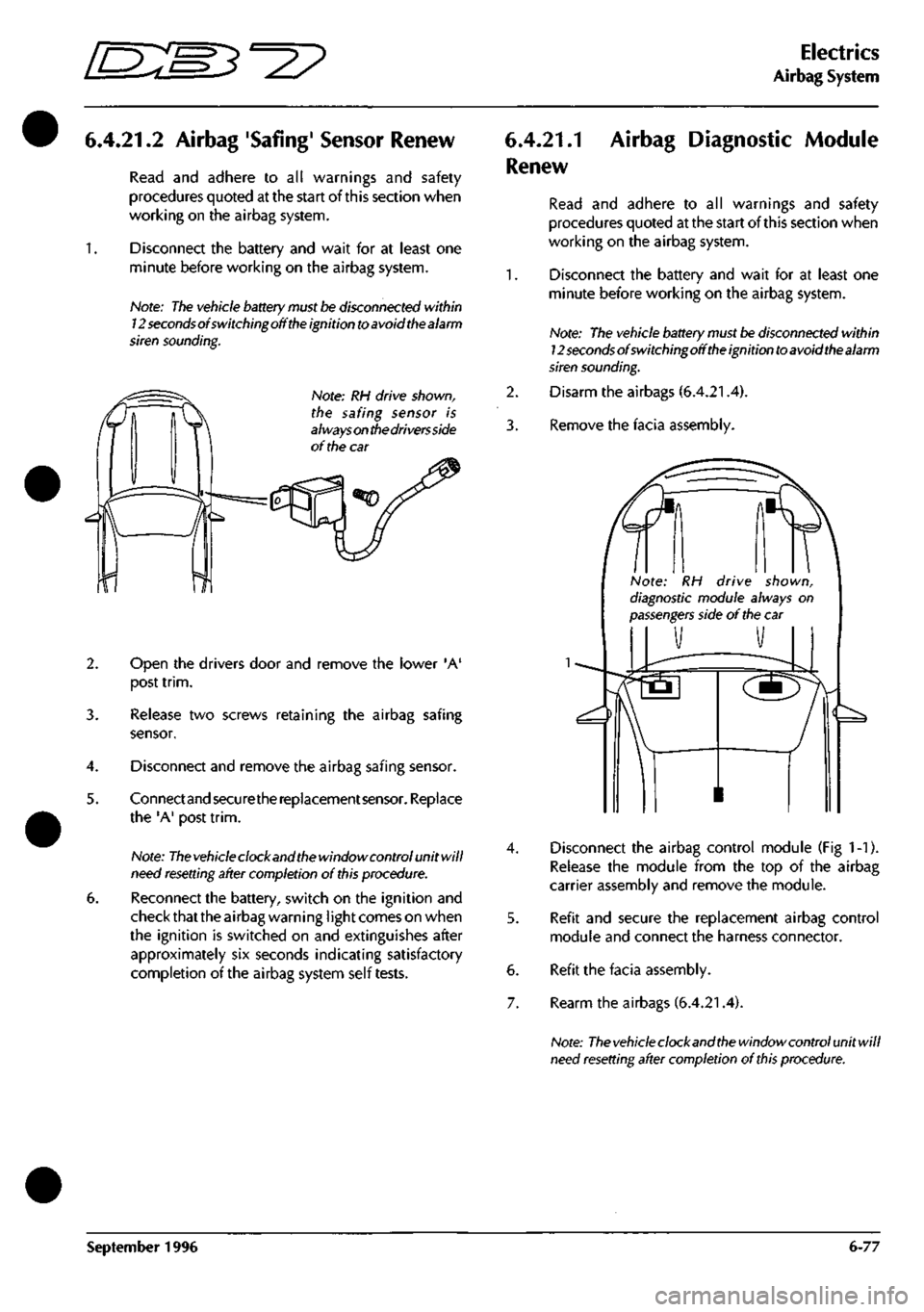
^7
Electrics
Airbag System
6.4.21.2
Airbag 'Safing' Sensor Renew
Read and adhere to all warnings and safety
procedures quoted at the start of this section when
working on the airbag system.
1.
Disconnect the battery and wait for at least one
minute before working on the airbag system.
Note:
The
vehicle battery must be disconnected within
12 secondsofswitchingoffthe ignition to avoid the alarm
siren sounding.
^h
Note: RH drive shown,
the safing sensor is
always
on
the drivers side
of the car
2. Open the drivers door and remove the lower 'A'
post
trim.
3. Release two screws retaining the airbag safing
sensor.
4.
Disconnect and remove the airbag safing sensor.
5. Connectand securethe replacement sensor. Replace
the 'A' post
trim.
Note:
The
vehicle clock and
the
window control unit will
need
resetting
after completion of
this
procedure.
6. Reconnect the battery, switch on the ignition and
check that the airbag warning
I
ight comes on when
the ignition is switched on and extinguishes after
approximately six seconds indicating satisfactory
completion of the airbag system self tests.
6.4.21.1
Renew
Airbag Diagnostic Module
1.
2.
3.
4.
6.
7.
Read and adhere to all warnings and safety
procedures quoted at the start of this section when
working on the airbag system.
Disconnect the battery and wait for at least one
minute before working on the airbag system.
Note: The vehicle battery must
be
disconnected within
l2secondsofswitchingofftheignitiontoavoidthealarm
siren
sounding.
Disarm the airbags (6.4.21.4).
Remove the facia assembly.
Note: RH drive shown,
diagnostic module always on
passengers
side of
the
car
Disconnect the airbag control module (Fig 1-1).
Release the module from the top of the airbag
carrier assembly and remove the module.
Refit and secure the replacement airbag control
module and connect the harness connector.
Refit the facia assembly.
Rearm the airbags (6.4.21.4).
Note:
The
vehicle clock and
the
window control unit will
need
resetting
after completion of this procedure.
September 1996 6-77
Page 196 of 421
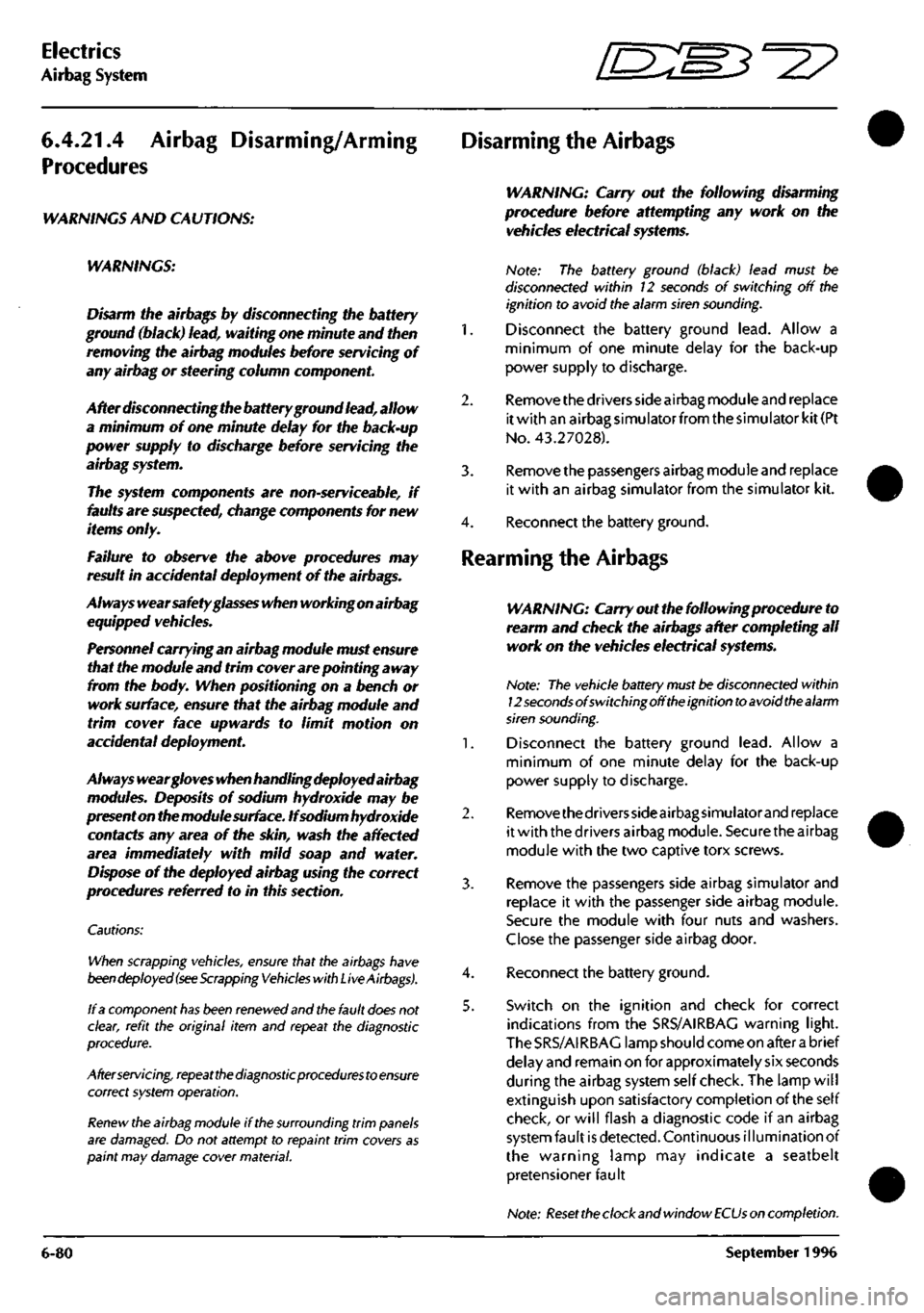
Electrics
Airbag System ^2?
6.4.21.4
Airbag Disarming/Arming
Procedures
WARNINGS AND CAUTIONS:
WARNINGS:
Disarm the airbags by disconnecting the battery
ground (black)
lead,
waiting one minute and then
removing the airbag modules before servicing of
any airbag or steering column component.
After disconnecting the battery ground
lead,
allow
a minimum of one minute delay for the back-up
power supply to discharge before servicing the
airbag system.
The system components are non-serviceable, if
faults are
suspected,
change components for new
items
only.
Failure to observe the above procedures may
result in accidental deployment of the airbags.
Always wear safety
glasses
when working on airbag
equipped vehicles.
Personnel carrying an airbag module must ensure
that the module and trim cover are pointing away
from the
body.
When positioning on a bench or
work surface, ensure that the airbag module and
trim cover face upwards to limit motion on
accidental deployment.
Always wear
gloves
when handling deployed airbag
modules. Deposits of sodium hydroxide may be
presenton the module surface. If sodium hydroxide
contacts any area of the skin, wash the affected
area immediately with mild soap and
water.
Dispose of the deployed airbag using the correct
procedures referred to in this section.
Cautions:
When scrapping vehicles,
ensure
that the
airbags
have
been deployed (see
Scrapping Vehicles
with Live
Airbags).
If a component
has been
renewed and the fault
does
not
clear,
refit the original item and repeat the diagnostic
procedure.
After
servicing,
repeatthe diagnostic
procedures
to ensure
correct
system
operation.
Renew
the airbag module if the surrounding trim
panels
are
damaged.
Do not attempt to repaint trim covers as
paint may
damage
cover material.
Disarming the Airbags
3.
4.
WARNING: Carry out the following disarming
procedure before attempting any work on the
vehicles electrical
systems.
Note: The battery ground (black) lead must be
disconnected within 12 seconds of switching off the
ignition to avoid the alarm siren sounding.
Disconnect the battery ground
lead.
Allow a
minimum of one minute delay for the back-up
power supply to discharge.
Remove the drivers side airbag module and replace
it with an airbag simulatorfrom the simulator kit (Pt
No.
43.27028).
Remove the passengers airbag module and replace
it with an airbag simulator from the simulator kit.
Reconnect the battery ground.
Rearming the Airbags
WARNING: Carry out the following procedure to
rearm and check the airbags after completing all
work on the vehicles electrical
systems.
Note: The vehicle battery
must be
disconnected within
12
seconds
of switching off
the
ignition
to
avoid the alarm
siren sounding.
^. Disconnect the battery ground
lead.
Allow a
minimum of one minute delay for the back-up
power supply to discharge.
2.
Removethedriverssideairbagsimulatorand replace
it with the drivers airbag module. Secure the airbag
module with the two captive torx screws.
3. Remove the passengers side airbag simulator and
replace it with the passenger side airbag module.
Secure the module with four nuts and washers.
Close the passenger side airbag door.
4.
Reconnect the battery ground.
5. Switch on the ignition and check for correct
indications from the SRS/AIRBAG warning light.
TheSRS/AIRBAC lamp should come on after
a
brief
delay and remain on for approximately six seconds
during the airbag system self check. The lamp will
extinguish upon satisfactory completion of the self
check, or will flash a diagnostic code if an airbag
system fault is detected. Continuous illumination of
the warning lamp may indicate a seatbelt
pretensioner fault
Note:
Reset the
clock and window
ECUs
on completion.
6-80 September 1996
Page 200 of 421
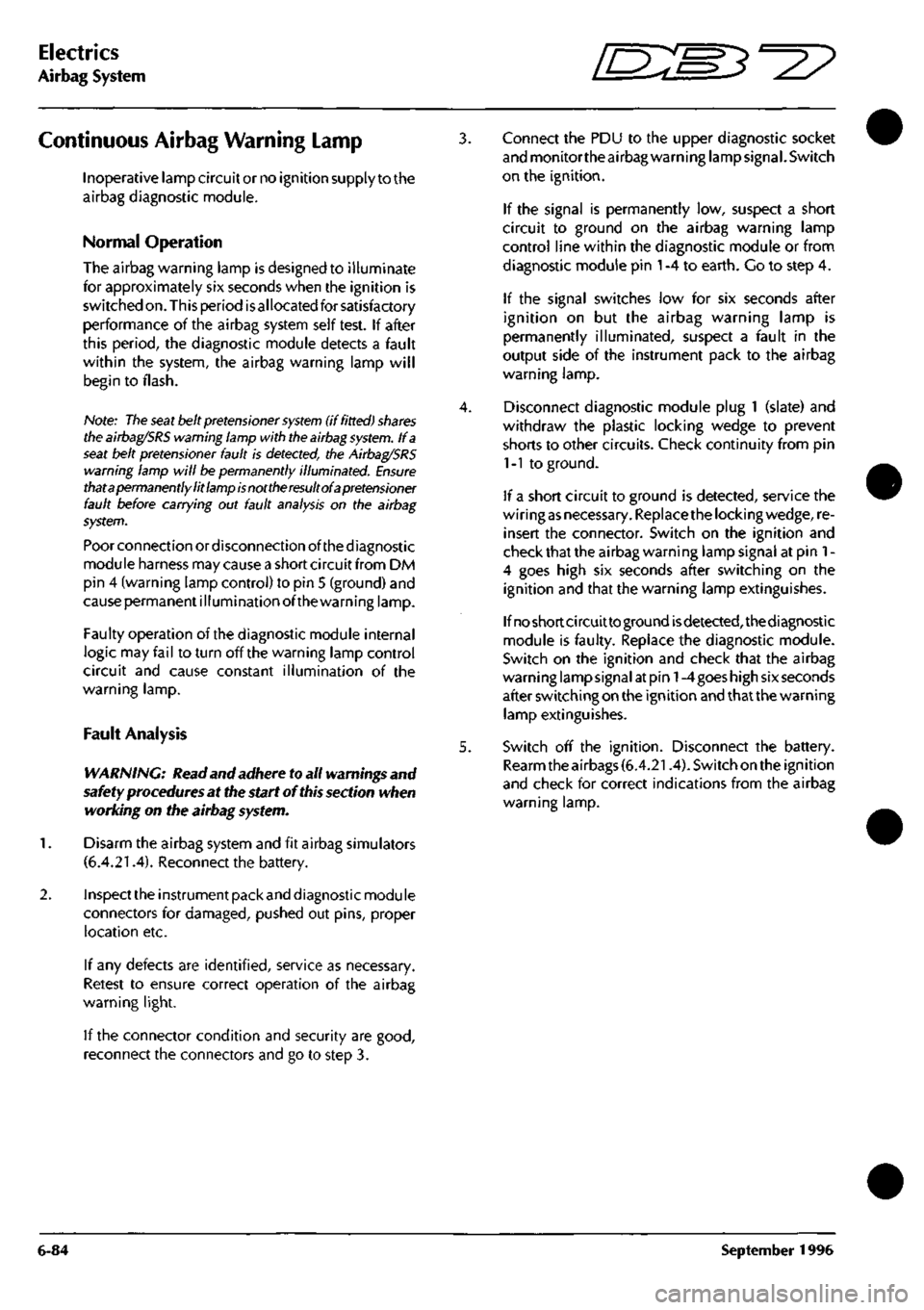
Electrics
Airbag System [EE:^^^?
Continuous Airbag Warning Lamp
Inoperative lamp circuit or no ignition supply to the
airbag diagnostic module.
Normal Operation
The airbag warning lamp is designed to illuminate
for approximately six seconds when the ignition is
switched
on.
This period isallocated for satisfactory
performance of the airbag system self test. If after
this period, the diagnostic module detects a fault
within the system, the airbag warning lamp will
begin to flash.
Note:
The seat
belt
pretensioner system
(if fitted)
shares
the
airbag/SRS
warning lamp with
the airbag
system.
If a
seat belt pretensioner fault is
detected,
the
Airbag/SRS
warning lamp will be permanently illuminated. Ensure
thata permanently lit
lamp
is nottheresultof a pretensioner
fault before carrying out fault analysis on the airbag
system.
Poor connection or disconnection of the diagnostic
module harness may cause a short circuit from DM
pin 4 (warning lamp control) to pin 5 (ground) and
cause permanent illumination ofthe warning lamp.
Faulty operation of the diagnostic module internal
logic may fail to turn off the warning lamp control
circuit and cause constant illumination of the
warning lamp.
Fault Analysis
WARNING: Read and adhere to all warnings and
safety procedures at the start of this section when
working on the airbag system.
1.
Disarm the airbag system and fit airbag simulators
(6.4.21.4). Reconnect the battery.
2.
Inspectthe instrument pack and diagnostic module
connectors for damaged, pushed out pins, proper
location etc.
If any defects are identified, service as necessary.
Retest to ensure correct operation of the airbag
warning light.
If the connector condition and security are good,
reconnect the connectors and go to step 3.
5.
Connect the PDU to the upper diagnostic socket
and monitorthe airbag warning lamp
signal.
Switch
on the ignition.
If the signal is permanently low, suspect a short
circuit to ground on the airbag warning lamp
control line within the diagnostic module or from
diagnostic module pin
1
-4 to earth. Co to step 4.
If the signal switches low for six seconds after
ignition on but the airbag warning lamp is
permanently illuminated, suspect a fault in the
output side of the instrument pack to the airbag
warning lamp.
Disconnect diagnostic module plug 1 (slate) and
withdraw the plastic locking wedge to prevent
shorts to other circuits. Check continuity from pin
1-1 to ground.
If a short circuit to ground is detected, service the
wiring
as
necessary. Replacethe locking
wedge,
re
insert the connector. Switch on the ignition and
check that the airbag warning lamp signal atpin 1-
4 goes high six seconds after switching on the
ignition and that the warning lamp extinguishes.
If no short circuitto ground isdetected,thediagnostic
module is faulty. Replace the diagnostic module.
Switch on the ignition and check that the airbag
warning lamp signal at pin
1
-4 goes high six seconds
after switching on the ignition and that the warning
lamp extinguishes.
Switch off the ignition. Disconnect the battery.
Rearm the airbags (6.4.21.4). Switch on the
ign
ition
and check for correct indications from the airbag
warning lamp.
6-84 September 1996
Page 202 of 421

Electrics
Airbag System ^2?
Airbag DM Fault Code 13
Airbag circuit short to ground
Normal Operation
The diagnostic modu
le
measures the voltage at pins
2-5 and 2-6. The voltage at these pins is dependant
on charging system voltage as shown in the table
belovi-.
'in 2-5
2.3V
2.4 V
2.5V
2.7V
2.8V
3.0V
3.1V
3.2V
3.4V
3.5V
3.7V
3.8V
4.0V
4.1V
4.3V
Pin 2-6
2.3V
2.4V
2.5V
2.7V
2.8V
3.0V
3.1V
3.2V
3.4V
3.5V
3.7V
3.8V
4.0V
4.1V
4.3V
Charge Volts
9.0V
9.5V
lO.OV
10.5V
11.OV
11.5V
12.0V
12.5V
13.0V
13.5V
14.0V
14.5V
15.0V
15.5V
16.0V
If the diagnostic monitor measures a voltage of 2.0
volts or less on pins 2-5 and 2-6, a fau It code 13 will
be generated and flashed to the instrument pack to
be signalled on the airbag warning lamp. Voltages
as low as 2.0 volts indicate a possible short to
ground in these circuits.
When generating a code 13 the diagnostic module
also generates a signal to blow its own internal
thermal fuse. This action disables the airbag
deployment circuit. The airbag diagnostic module
fuse is non-repairable and the module must be
replaced after repairing the short circuit, if the
voltage at pins 2-5 and 2-6 returns to normal, fault
code 51 (blown thermal fuse) will be stored in
memory.
6.
Fault Analysis
WARNING: Read and adhere to all warnings and
safety procedures at the start of this section when
working on the airbag
system.
Disarm the airbag system and fit airbag simulators
(6.4.21.4)
Disconnect the airbag diagnostic module. Switch
on the ignition.
Measure the continuity to ground at the following
pins on the diagnostic module harness connector:
2-2 Passenger airbag feed
2-3 Passenger airbag return
2-4 Drivers airbag return
2-5 Drivers airbag feed
2-11 Safing sensor feed
If no short circuit is detected, go to step 4.
If
a
short circuit is detected, disconnect the relevant
airbag simulator or the safing sensor and repeat the
continuity measurement to isolate the circuit fault.
Service the wiring or replace the safing sensor as
necessary. Fit a new airbag diagnostic module and
rearm the airbags (6.4.21.4).
Check for intermittent short circuits in the cable
reel cassette. Monitor the continuity to ground at
pins 2-4 and 2-5 whilst rotating the steering from
lock to lock in both directions.
If no short circuit is detected, go to step 5.
If a short circuit is detected, replace the column
switchgear assembly. Fit a new airbag diagnostic
module and rearm the airbags (6.4.21.4).
WARNING: Do not attempt to make any electrical
measurements on the airbag
modules.
Any induced
voltage can
cause
the airbag
to
deploy with the
risk
of personal
injury.
Fit a replacement diagnostic module and
replacement airbag modules.
Caution: Do not refit
the
old
airbag
modules.
They may
be faulty and would
damage the
new diagnostic module.
Rearm the airbag system (6.4.21.4).
6-86 September 1996
Page 204 of 421
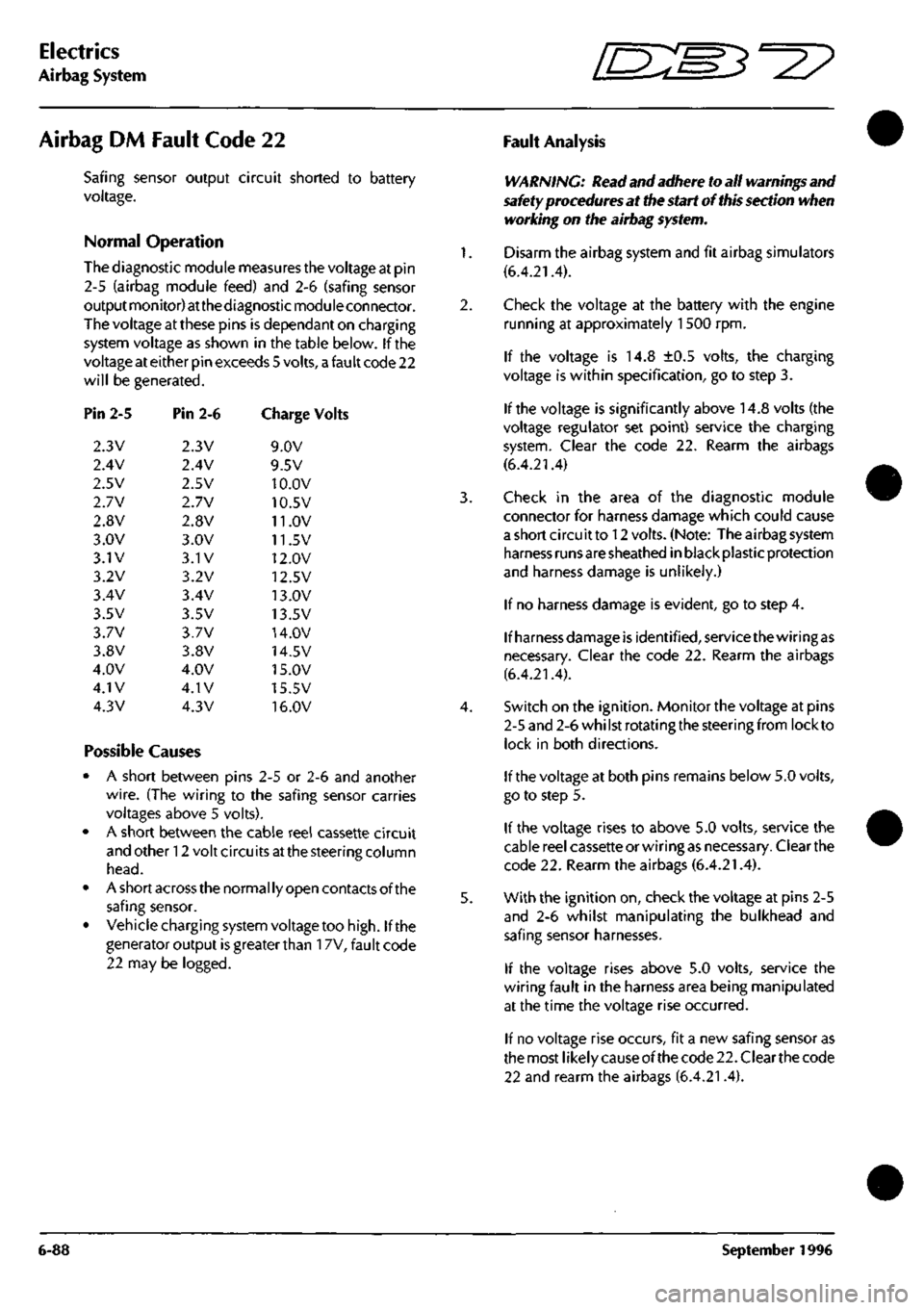
Electrics
Airbag System [D:B3-2?
Airbag DM Fault Code 22
Safing sensor output circuit shorted to battery
voltage.
Normal Operation
The diagnostic module measures the voltage at pin
2-5 (airbag module feed) and 2-5 (safing sensor
output monitor) at thediagnosticmoduleconnector.
The voltage at these pins is dependant on charging
system voltage as shown in the table below. If the
voltage at either pin exceeds 5 volts,
a
fault code 22
will be generated.
in 2-5
2.3V
2.4V
2.5V
2.7V
2.8V
3.0V
3.1V
3.2V
3.4 V
3.5V
3.7V
3.8V
4.0V
4.1V
4.3V
Pin 2-6
2.3V
2.4V
2.5V
2.7V
2.8V
3.0V
3.1V
3.2 V
3.4 V
3.5V
3.7V
3.8V
4.0V
4.1V
4.3V
Charge Volts
9.0V
9.5V
10.0V
10.5V
11.0V
11.5V
12.0V
12.5V
13.0V
13.5V
14.0V
14.5V
15.0V
15.5V
16.0V
Possible Causes
• A short between pins 2-5 or 2-6 and another
wire.
(The wiring to the safing sensor carries
voltages above 5 volts).
• A short between the cable reel cassette circuit
and other 12 volt circu its at the steering column
head.
• A short across the normal ly open contacts of the
safmg sensor.
• Vehiclechargingsystem voltage too
high.
If the
generator output is greater than 17V, fault code
22 may be logged.
Fault Analysis
WARNING: Read and adhere to all warnings and
safety procedures at the start of this section when
working on the airbag system.
Disarm the airbag system and fit airbag simulators
(6.4.21.4).
Check the voltage at the battery with the engine
running at approximately 1500 rpm.
If the voltage is 14.8 ±0.5 volts, the charging
voltage is within specification, go to step 3.
If the voltage is significantly above 14.8 volts (the
voltage regulator set point) service the charging
system.
Clear the code 22. Rearm the airbags
(6.4.21.4)
Check in the area of the diagnostic module
connector for harness damage which could cause
a short circu it to 12 volts. (Note: The airbag system
harness runs are sheathed in black plastic protection
and harness damage is unlikely.)
If no harness damage is evident, go to step 4.
If harness damage is identified, service the wiring as
necessary. Clear the code 22. Rearm the airbags
(6.4.21.4).
Switch on the ignition. Monitor the voltage at pins
2-5 and 2-6 whilst rotatingthe steering from lock to
lock in both directions.
If the voltage at both pins remains below 5.0 volts,
go to step 5.
If the voltage rises to above 5.0 volts, service the
cable reel cassette or wiring as necessary. Clear the
code 22. Rearm the airbags (6.4.21.4).
With the ignition on, check the voltage at pins 2-5
and 2-6 whilst manipulating the bulkhead and
safing sensor harnesses.
If the voltage rises above 5.0 volts, service the
wiring fault in the harness area being manipulated
at the time the voltage rise occurred.
If no voltage rise occurs, fit a new safing sensor as
the most likely cause of the code 22. Clear the code
22 and rearm the airbags (6.4.21.4).
6-88 September 1996